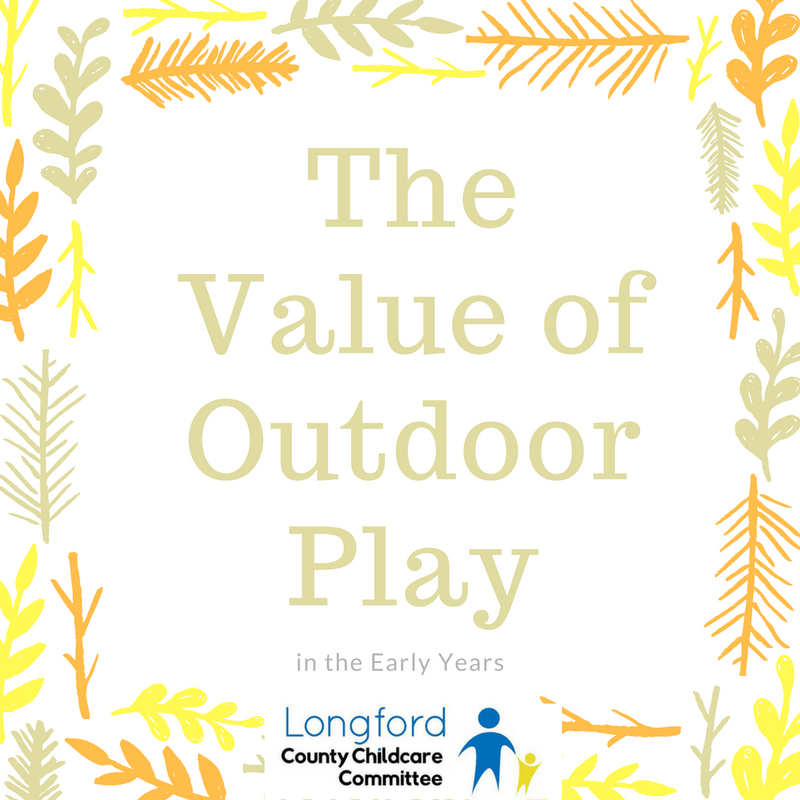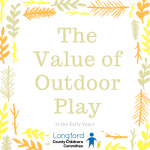The Value of Outdoor Play in the Early Years.
It has been long documented that Outdoor Play has many benefits for young children. Research has shown that children who play outdoors regularly are happier, healthier, fitter and stronger. As early years educators, it is our responsibility to promote and encourage meaningful outdoor play opportunities in our preschool settings.
Encouraging children to get outside, get moving, and connect with the natural world are all ways to tackle our increasing rates of childhood obesity in Ireland.
Additionally, many of the developmental tasks that children must achieve—exploring, risk-taking, fine and gross motor development and the absorption of vast amounts of basic knowledge—can be most effectively learned through outdoor play. Despite this children are spending increasing amounts of time indoors.
Think back to your own childhood. What did outdoor play mean to you? For many of us it was a place of freedom, fun and opportunity. Can children of today make similar memories?
Children have an inherent attraction and connection to the outdoor world and all it can offer them. If this is not encouraged and facilitated, children may lose this connection as they grow older. Early Years is a significant time of development for children and a love of the outdoors must be nurtured through curriculum planning.
Outdoor play incorporates all four Aistear themes as children will naturally Explore and Think when playing. Outdoor play can positively benefit a child’s Well Being as physical exercise can make a child as fit and healthy as they can be. Communication is improved as children interact with peers and they will begin to see themselves as capable learners as they assess and take risks, improving their sense of Identity and Belonging.
Síolta standard 2 ENVIRONMENT is in place to support outdoor play as it tell us that both indoor and outdoor environments should be well planned out and accommodate the needs of the child. Standard 5 INTERACTIONS and 6 PLAY are evident in outdoor play as children learn to interact and communicate with each other through the medium of outdoor play.
The Outdoor Learning Environment
The outdoor learning environment has a significant impact on what and how children learn. The care and attention we pay to organising space outdoors stimulates children’s imagination, creativity, exploration, discovery, engagement and sense of wonder in the world around them. Planning and design of the outdoor environment should support inclusion and meet the needs of individuals, offering a diverse range of play experiences. The environment should invite children to engage in play: alone, in small groups and in large groups. Like your indoor environment, the outdoor environment must have a range of interest areas. Activities that can be engaged in inside, can also be carried on outside, for example, reading stories, taking part in pretend play, doing group art projects and playing with sand or water. In the outdoors, activities can also be provided on a larger and more expansive scale (NCCA, 2009).
We will look at some possible interest areas for your outdoor environment and discuss the benefits of each.
Sand & Water Area
Sand and water are integral aspects of the outdoor environment. Conversely to the indoors, these sensory activities can be experienced outdoors with the whole body promoting sensory development in young children. There is no right way to use sand and water. They invite participation; they permit children to make and test hypotheses; they develop the imagination; and are an excellent avenue for children to learn physical, cognitive, and social skills.
As sand and water play are open-ended, the child determines the direction and path of his or her own play. This freedom then clears the way for the child to build developmental concepts.
Pretend Play
We know that children love to experiment and pretend in their play. They do this as they are rehearsing for real life situations in a safe environment. Children should be given the opportunity to engage in pretend play as much as possible outdoors. A firm favourite among pre-schoolers is the mud kitchen. Filled with real life pots, pans, kettles and enamel utensils, this area can be an oasis of imaginative exploration.
Mud play allows children to connect and interact with the natural world around them and mud is a material which stimulates creativity as it facilitates open-ended play, communication, collaboration and physical activity.
Mud Kitchens are inexpensive to create and stock.
Music Area
To facilitate music play it is vital that children have access to instruments freely and regularly and so it is the responsibility of the practitioner to arrange the environment to ensure children can choose to play with music. Music play tends to be loud and energetic so the outdoor environment can provide an ideal space for musical exploration. To make your outdoor music area use:
- Pot lids, pots, metal mixing bowls, empty cans
- Metal and plastic buckets
- Metal oven griddles
- Tin trays or plates
- Lengths of wood or bamboo
- Short lengths of aluminium pipe, steel rods and long bolts (when suspending these or wood/ bamboo try to suspend them at 1/4 of the total length of the item – this will make them vibrate best)
- Old spanners and other tools
- Plastic bottle shakers – filled with sand, rice, beans, macaroni, etc.
- Anything that makes a sound when struck, and which will not break easily.
Outdoor Art
Art is a basic activity in preschool. What better inspiration for budding artists than nature and all the sensual, visual and auditory stimulus it offers. Children can use Mother Nature to create their own masterpieces. Leaves, twigs, shells, pebbles, rocks, bark and grass can all be utilised to create individual works of art for each child. If it is not possible to display the children’s nature art, take a photograph to discuss with the children and share with parents.
Gross Motor Play
Walking & Climbing: Walking up and down hills and obstacles or over uneven surfaces can help build strength and endurance.
Chalk: When a child draws on the ground they may squat down, which strengthens legs. Alternatively they lie on their tummies which helps to strengthen upper bodies.
Open Ended Materials: Open ended resources such as ribbon, skipping ropes and hula hoops can be used in many ways to encourage imagination and creativity.
Wheeled Toys: Riding a bike or a scooter will help children work on coordination, endurance and overall strengthening.
Ball Games: Playing a friendly game of catch will help your child develop hand-eye coordination, motor planning and social skills. When playing an organised game with friends, children learn the concept of taking turns and good sportsmanship.
Gardening: Encourage children to help you with maintenance projects around the garden such as weeding, watering plants and raking leaves.
Why is Nature Important in Outdoor Play?
There is a growing body of research about the multiple positive impacts of nature play on children’s social, emotional, intellectual, and physical well-being.
Recent research highlights many benefits to children engaging with nature:
- Children who play regularly in natural settings are sick less often. Mud, sand, water, leaves, sticks and pine cones can help to stimulate children’s immune system as well as their imagination.
- Children who spend more time outside are more physically active and less likely to be overweight. Children who play in natural settings are more resistant to stress, have lower levels of anxiety and depression, and have a higher level of self-worth.
- Children who play in natural settings play in more diverse, imaginative and creative ways and show improved language and collaboration skills.
- Natural, irregular and challenging spaces help children to learn to recognise, assess and negotiate risk and to build confidence and competence.
- Children who play in nature have more positive feelings about each other.
Create a Bug Hotel
What better way to add to the nature and biodiversity of your garden than with a simple bug hotel. They are easy to make and the benefits to your garden, the environment and the children’s learning about nature are immeasurable.
There is no standard design for an insect hotel. They can be created using available resources — preferably recycled and natural materials such as old pallets, clay pots, clay pipes, bricks, carpets etc. Insect hotels come in many shapes and sizes but to be effective they need to have many small holes and cavities that insects can crawl or fly into.
Contact your local Environmental Awareness Officer in the County Council for ideas on bringing biodiveristy to your garden.
Gardening
Gardening with children is a wonderful opportunity to explore nature and witness life and growth at their level. It provides opportunities to explore through designing, planting, harvesting, preparing, and growing food. It encourages children to work cooperatively in groups and learn about science and nutrition. Gardening is possible in all outdoor spaces – big or small. Upcycled materials such as old tyres, wellie boots and pallets make great foundations for gardening. Depending on your choice of planting material you can encourage the development of the senses through touch, sight and smell, you can encourage seasonal visitors to your garden. Speak to your local garden centre about what plants, fruit and vegetables are suitable for your area. The process of gardening is much more important for children, than the results of their labour. Remember this as you design your gardening area.
It is important that children have the space to dig freely, so try to provide an additional digging area apart from your gardening area.
Provide small watering cans or buckets for the children to water their plants. Consider the use of a water butt to ensure recycling of water.
Getting dirty is all part of the gardening experience – embrace and encourage it!
Risk Appropriate Play
Children are continuously trying out new things and learning a great deal about adventure and challenge in the process. They face the risk of mistakes and even of injuries. We must allow them the opportunities to take these risks and involve them in risk assessing their own environment. When children are given a chance to engage freely in risky play they quickly learn to evaluate their own skills and match them to the demands of the environment. Such children ask themselves — consciously or unconsciously — “how high can I climb”, or “is this branch strong enough to support me?” They learn about themselves and their environment. Children who are confident about taking chances rebound well when things do not work out at first. They are resilient and will try again and again until they master a situation that challenges them—or wisely avoid it, if that seems best. As early years practitioners we have responsibility to promote, encourage and facilitate risk appropriate play. It is advisable to have a risky play policy and an outdoor risk assessment procedure to ensure best practice for children and adults.
Consultation with Stakeholders
We must remember that children should have a voice in all matters that affect their development. We must look at them as experts on their lives, from whom we can learn a lot. We create an outdoor environment for them to learn and explore we must seek out their thoughts and opinions and base our planning around this. Practitioners must acknowledge that listening to children is challenging for adults. It requires both skill and the will to take the child’s opinions into consideration.
Consultation with parents is also important in the development of a new learning space for children. Aistear and Síolta highlights the important role parents and families play in children’s lives. Parents will have ideas of what they enjoyed as children and may have some practical suggestions to get the project off the ground.
Pre Literacy Skills in the Outdoor Environment
The skill of writing begins with mark making. Mark making, drawing, writing and reading are all closely bound up with a child’s communication and language development. As well as enabling a child to learn to write, mark making can benefit a child physically, developing a child’s fine motor skills and also helps to develop their imagination and creative skills. There are many opportunities for mark making in the outdoor environment.
Pre Numeracy Skills in the Outdoor Environment
Children are using early math skills throughout their daily routines and activities. But what is early numeracy? It is more than learning to count and quantify. It is
Understanding size, shape, pattern, weight, balance, height, length, width etc.
Identifying more and less of a quantity
There are ample opportunities to promote pre numeracy skills in the outdoor environment.
Aistear Síolta Practice Guide
To help you plan, organize and evaluate your outdoor learning area you should use the Aistear Síolta Practice Guide available at www.aistearsiolta.ie. This Guide will assist you to critically reflect on the outdoor experience that you offer, acknowledge what is working well and identify priorities for development and to plan actions for positive change. In this way, the Practice Guide can be used for on-going review, development and improvement by practitioners and early childhood settings.
For further inspiration please see our podcast and practitioner booklet on this topic.


